Input interpretation

bismuth (chemical element) | indium (chemical element) | lead (chemical element)
Periodic table location

Periodic table location
Images
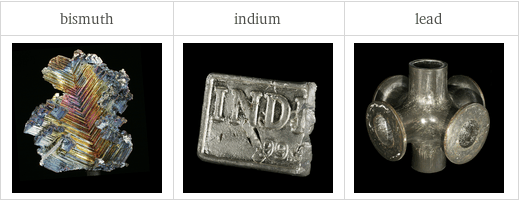
Images
Basic elemental properties
![| bismuth | indium | lead atomic symbol | Bi | In | Pb atomic number | 83 | 49 | 82 short electronic configuration | [Xe]6s^24f^145d^106p^3 | [Kr]5s^24d^105p^1 | [Xe]6s^24f^145d^106p^2 Aufbau diagram | 6p 5d 4f 6s | 5p 4d 5s | 6p 5d 4f 6s block | p | p | p group | 15 | 13 | 14 period | 6 | 5 | 6 atomic mass | 208.9804 u | 114.818 u | 207.2 u half-life | 1.9×10^19 yr | (stable) | (stable)](../image_source/786111e0ce5b95e1ddd3381740d997cf.png)
| bismuth | indium | lead atomic symbol | Bi | In | Pb atomic number | 83 | 49 | 82 short electronic configuration | [Xe]6s^24f^145d^106p^3 | [Kr]5s^24d^105p^1 | [Xe]6s^24f^145d^106p^2 Aufbau diagram | 6p 5d 4f 6s | 5p 4d 5s | 6p 5d 4f 6s block | p | p | p group | 15 | 13 | 14 period | 6 | 5 | 6 atomic mass | 208.9804 u | 114.818 u | 207.2 u half-life | 1.9×10^19 yr | (stable) | (stable)
Thermodynamic properties
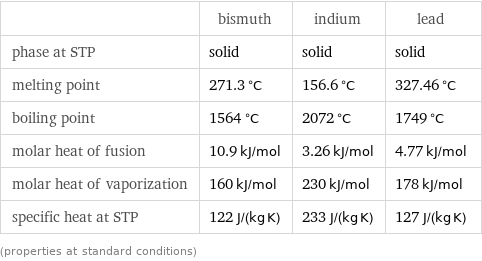
| bismuth | indium | lead phase at STP | solid | solid | solid melting point | 271.3 °C | 156.6 °C | 327.46 °C boiling point | 1564 °C | 2072 °C | 1749 °C molar heat of fusion | 10.9 kJ/mol | 3.26 kJ/mol | 4.77 kJ/mol molar heat of vaporization | 160 kJ/mol | 230 kJ/mol | 178 kJ/mol specific heat at STP | 122 J/(kg K) | 233 J/(kg K) | 127 J/(kg K) (properties at standard conditions)
Material properties
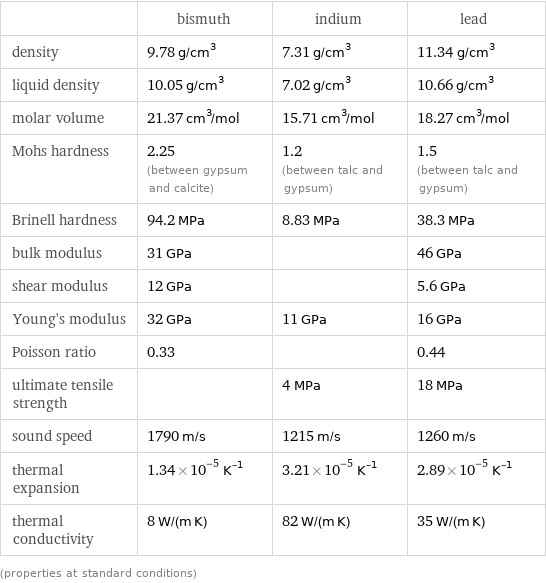
| bismuth | indium | lead density | 9.78 g/cm^3 | 7.31 g/cm^3 | 11.34 g/cm^3 liquid density | 10.05 g/cm^3 | 7.02 g/cm^3 | 10.66 g/cm^3 molar volume | 21.37 cm^3/mol | 15.71 cm^3/mol | 18.27 cm^3/mol Mohs hardness | 2.25 (between gypsum and calcite) | 1.2 (between talc and gypsum) | 1.5 (between talc and gypsum) Brinell hardness | 94.2 MPa | 8.83 MPa | 38.3 MPa bulk modulus | 31 GPa | | 46 GPa shear modulus | 12 GPa | | 5.6 GPa Young's modulus | 32 GPa | 11 GPa | 16 GPa Poisson ratio | 0.33 | | 0.44 ultimate tensile strength | | 4 MPa | 18 MPa sound speed | 1790 m/s | 1215 m/s | 1260 m/s thermal expansion | 1.34×10^-5 K^(-1) | 3.21×10^-5 K^(-1) | 2.89×10^-5 K^(-1) thermal conductivity | 8 W/(m K) | 82 W/(m K) | 35 W/(m K) (properties at standard conditions)
Electromagnetic properties
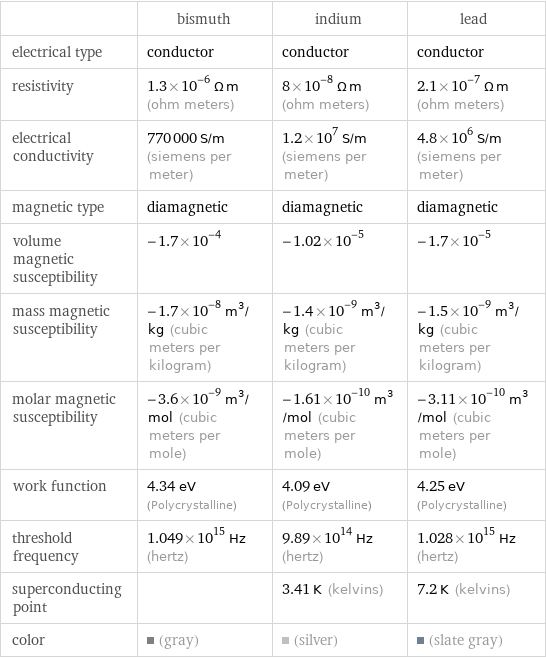
| bismuth | indium | lead electrical type | conductor | conductor | conductor resistivity | 1.3×10^-6 Ω m (ohm meters) | 8×10^-8 Ω m (ohm meters) | 2.1×10^-7 Ω m (ohm meters) electrical conductivity | 770000 S/m (siemens per meter) | 1.2×10^7 S/m (siemens per meter) | 4.8×10^6 S/m (siemens per meter) magnetic type | diamagnetic | diamagnetic | diamagnetic volume magnetic susceptibility | -1.7×10^-4 | -1.02×10^-5 | -1.7×10^-5 mass magnetic susceptibility | -1.7×10^-8 m^3/kg (cubic meters per kilogram) | -1.4×10^-9 m^3/kg (cubic meters per kilogram) | -1.5×10^-9 m^3/kg (cubic meters per kilogram) molar magnetic susceptibility | -3.6×10^-9 m^3/mol (cubic meters per mole) | -1.61×10^-10 m^3/mol (cubic meters per mole) | -3.11×10^-10 m^3/mol (cubic meters per mole) work function | 4.34 eV (Polycrystalline) | 4.09 eV (Polycrystalline) | 4.25 eV (Polycrystalline) threshold frequency | 1.049×10^15 Hz (hertz) | 9.89×10^14 Hz (hertz) | 1.028×10^15 Hz (hertz) superconducting point | | 3.41 K (kelvins) | 7.2 K (kelvins) color | (gray) | (silver) | (slate gray)
Reactivity
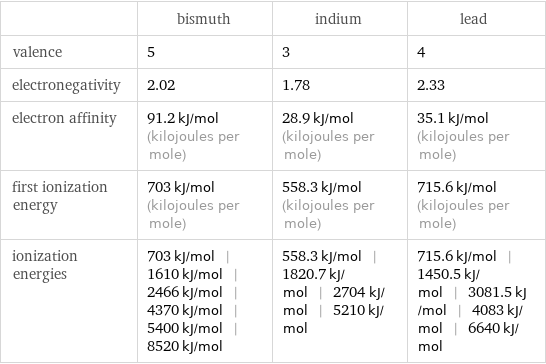
| bismuth | indium | lead valence | 5 | 3 | 4 electronegativity | 2.02 | 1.78 | 2.33 electron affinity | 91.2 kJ/mol (kilojoules per mole) | 28.9 kJ/mol (kilojoules per mole) | 35.1 kJ/mol (kilojoules per mole) first ionization energy | 703 kJ/mol (kilojoules per mole) | 558.3 kJ/mol (kilojoules per mole) | 715.6 kJ/mol (kilojoules per mole) ionization energies | 703 kJ/mol | 1610 kJ/mol | 2466 kJ/mol | 4370 kJ/mol | 5400 kJ/mol | 8520 kJ/mol | 558.3 kJ/mol | 1820.7 kJ/mol | 2704 kJ/mol | 5210 kJ/mol | 715.6 kJ/mol | 1450.5 kJ/mol | 3081.5 kJ/mol | 4083 kJ/mol | 6640 kJ/mol
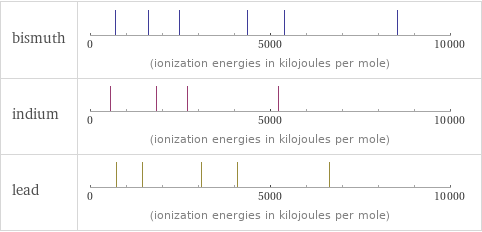
Reactivity
Atomic properties
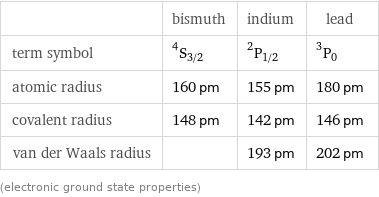
| bismuth | indium | lead term symbol | ^4S_(3/2) | ^2P_(1/2) | ^3P_0 atomic radius | 160 pm | 155 pm | 180 pm covalent radius | 148 pm | 142 pm | 146 pm van der Waals radius | | 193 pm | 202 pm (electronic ground state properties)
Abundances
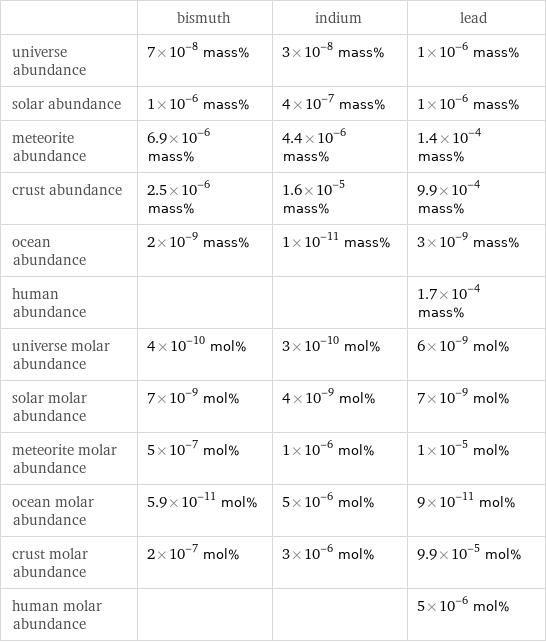
| bismuth | indium | lead universe abundance | 7×10^-8 mass% | 3×10^-8 mass% | 1×10^-6 mass% solar abundance | 1×10^-6 mass% | 4×10^-7 mass% | 1×10^-6 mass% meteorite abundance | 6.9×10^-6 mass% | 4.4×10^-6 mass% | 1.4×10^-4 mass% crust abundance | 2.5×10^-6 mass% | 1.6×10^-5 mass% | 9.9×10^-4 mass% ocean abundance | 2×10^-9 mass% | 1×10^-11 mass% | 3×10^-9 mass% human abundance | | | 1.7×10^-4 mass% universe molar abundance | 4×10^-10 mol% | 3×10^-10 mol% | 6×10^-9 mol% solar molar abundance | 7×10^-9 mol% | 4×10^-9 mol% | 7×10^-9 mol% meteorite molar abundance | 5×10^-7 mol% | 1×10^-6 mol% | 1×10^-5 mol% ocean molar abundance | 5.9×10^-11 mol% | 5×10^-6 mol% | 9×10^-11 mol% crust molar abundance | 2×10^-7 mol% | 3×10^-6 mol% | 9.9×10^-5 mol% human molar abundance | | | 5×10^-6 mol%